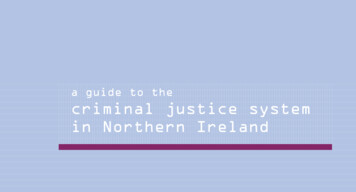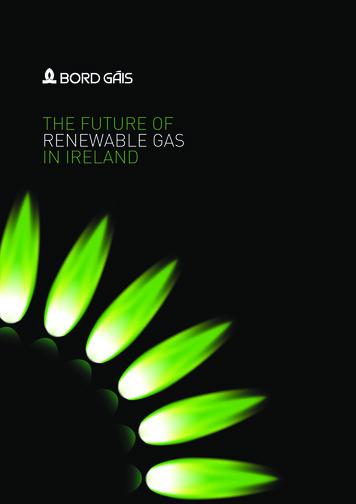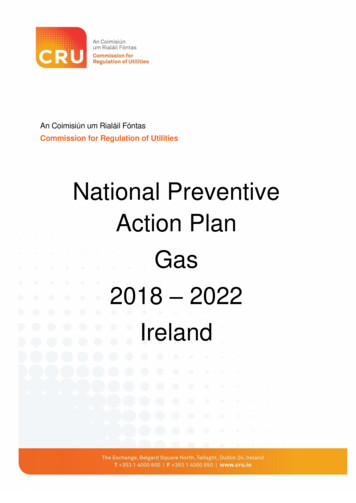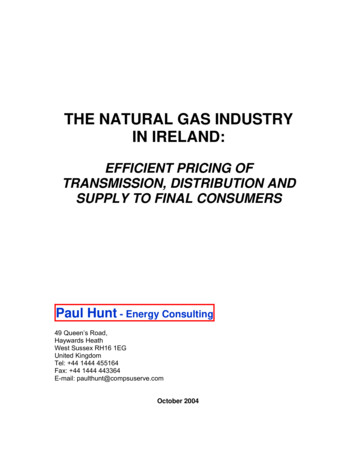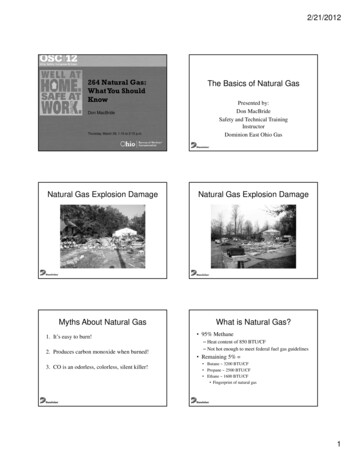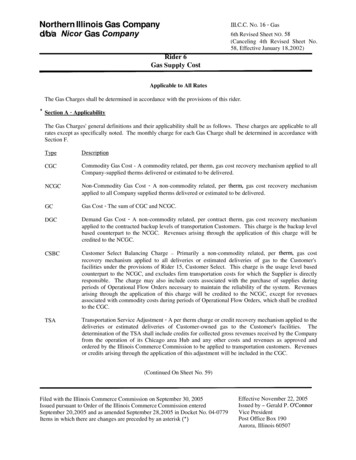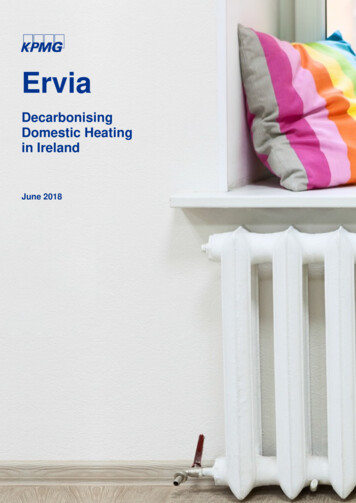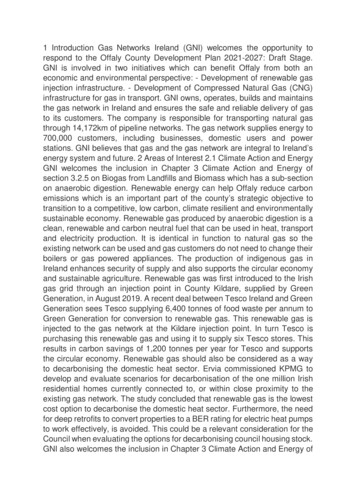
Transcription
1 Introduction Gas Networks Ireland (GNI) welcomes the opportunity torespond to the Offaly County Development Plan 2021-2027: Draft Stage.GNI is involved in two initiatives which can benefit Offaly from both aneconomic and environmental perspective: - Development of renewable gasinjection infrastructure. - Development of Compressed Natural Gas (CNG)infrastructure for gas in transport. GNI owns, operates, builds and maintainsthe gas network in Ireland and ensures the safe and reliable delivery of gasto its customers. The company is responsible for transporting natural gasthrough 14,172km of pipeline networks. The gas network supplies energy to700,000 customers, including businesses, domestic users and powerstations. GNI believes that gas and the gas network are integral to Ireland’senergy system and future. 2 Areas of Interest 2.1 Climate Action and EnergyGNI welcomes the inclusion in Chapter 3 Climate Action and Energy ofsection 3.2.5 on Biogas from Landfills and Biomass which has a sub-sectionon anaerobic digestion. Renewable energy can help Offaly reduce carbonemissions which is an important part of the county’s strategic objective totransition to a competitive, low carbon, climate resilient and environmentallysustainable economy. Renewable gas produced by anaerobic digestion is aclean, renewable and carbon neutral fuel that can be used in heat, transportand electricity production. It is identical in function to natural gas so theexisting network can be used and gas customers do not need to change theirboilers or gas powered appliances. The production of indigenous gas inIreland enhances security of supply and also supports the circular economyand sustainable agriculture. Renewable gas was first introduced to the Irishgas grid through an injection point in County Kildare, supplied by GreenGeneration, in August 2019. A recent deal between Tesco Ireland and GreenGeneration sees Tesco supplying 6,400 tonnes of food waste per annum toGreen Generation for conversion to renewable gas. This renewable gas isinjected to the gas network at the Kildare injection point. In turn Tesco ispurchasing this renewable gas and using it to supply six Tesco stores. Thisresults in carbon savings of 1,200 tonnes per year for Tesco and supportsthe circular economy. Renewable gas should also be considered as a wayto decarbonising the domestic heat sector. Ervia commissioned KPMG todevelop and evaluate scenarios for decarbonisation of the one million Irishresidential homes currently connected to, or within close proximity to theexisting gas network. The study concluded that renewable gas is the lowestcost option to decarbonise the domestic heat sector. Furthermore, the needfor deep retrofits to convert properties to a BER rating for electric heat pumpsto work effectively, is avoided. This could be a relevant consideration for theCouncil when evaluating the options for decarbonising council housing stock.GNI also welcomes the inclusion in Chapter 3 Climate Action and Energy of
the Climate Action and Energy Objectives on gas which support the furtherextension of the gas grid in Co. Offaly and also support and facilitate theproduction of low carbon gases such as biomethane and hydrogen whichcan be injected into the national gas network. 2.2 Sustainable Mobility andAccessibility Chapter 8 of the Offaly County Development Plan coversSustainable Mobility and Accessibility and within section 8.7 on SustainableMobility and Accessibility Policies it is highlighted that Council policypromotes the integration of land use and transport planning to reduceanthropogenic greenhouse gas emissions. Heavy Goods Vehicles (HGVs)are responsible for a disproportionate amount of transport emissions. Theycomprised 4% of registered vehicles nationally in 2018, however, SEAIestimates indicate that they produced 14% of total transport emissions.Decarbonisation of HGVs and buses is particularly challenging as electricityis currently not a viable alternative to diesel. CNG has the potential toaddress these transport emissions with reduced carbon emissions relativeto diesel. When the production of renewable gas is increased on the gasnetwork, and this gas is utilised by CNG vehicles as bio-CNG, carbon neutraltransport can be achieved. In addition to reduced carbon emissions, CNGalso provides improved air quality with less particulate matter, NitrogenOxide and Sulphur Dioxide relative to diesel. GNI suggests that theSustainable Mobility and Accessibility section of the Offaly CountyDevelopment Plan includes wording to support CNG infrastructure asfollows: Compressed Natural Gas (CNG) Infrastructure “The development ofCNG Infrastructure will enable fuel switching from diesel to CNG for heavygoods vehicles (HGVs. This will lead to a reduction in carbon emissionsalong with air quality benefits for vehicles currently using diesel. There willbe a presumption in favour of applications for CNG infrastructure providedplanning and environmental criteria are satisfied.” “The Council supports thedevelopment of Compressed Natural Gas (CNG) Vehicle usage andrefuelling infrastructure on sites owned and occupied by Offaly CountyCouncil and private sites through supportive policies and development ofcontrol standards in the County Development Plan.” The rollout of a networkof CNG refuelling facilities has commenced with 14 fast fill CNG stationsbeing installed across the Core TEN-T road network via a project called theCauseway Study that is supported by the European Commission through theCEF Transport Fund and by the Commission for Regulation of Utilities(CRU). Two of these stations are already operational, including one at DublinPort. This project helps support the ‘National Policy Framework: AlternativeFuels Infrastructure for Transport in Ireland (2017 to 2030)’, which sets outa target network of 70 CNG refuelling stations by 2025 . This document alsoforecasts Alternative Fuelled Vehicles for 2025 and 2030 i.e. 4,050 CNG
commercial vehicles in Ireland by 2025, growing to 6,050 CNG commercialvehicles by 2030. Under the Causeway Study, GNI also offered a publiclyavailable fund to support the purchase of CNG vehicles by commercialoperators. This fund was fully subscribed and is helping fleet operators totransition some of their fleet to CNG which provides fuel savings of up to35% compared to diesel. Following the completion of planned CNG stationsunder the Causeway Study, a further 21 public CNG refuelling stations willbe built under a project called Green Connect. This project will also includeCNG mobile refuelling units for backup, additional renewable gas injectionfacilities and a CNG vehicle grant scheme to encourage fleet operators toswitch to CNG vehicles. In 2018, GNI received approval for 11.6m of EUfunding under the CEF Transport Fund for the Green Connect project. Thedevelopment of CNG is supported by the ‘Eastern and Midland RegionalAssembly Regional Spatial and Economic Strategy 2019-2031 ’ (EMRARSES) which supports the “use of alternative cleaner fuels for home heatingand transport including the use of Compressed Natural Gas poweredcommercial vehicles”. The EMRA RSES also highlights that modal shift topublic transport or non-motorised transport should be supported throughimproved behaviour and improved transport infrastructure and that “thisshould be supported by increased availability of low carbon fuels/biofuelssuch as Compressed Natural Gas (CNG)”. The Council has highlighted thatthe overarching goals are prioritising sustainable transport modes in order toachieve improvements in air quality, reduction in both CO2 emissions andnoise levels. GNI believes that CNG and renewable gas have the potentialto make a considerable contribution to achieving sustainable transport in thenear term. 2.3 Biodiversity and Landscape GNI is cognisant of the naturalenvironment. Transportation of gas is unobtrusive and particular attention istaken to minimise the impact on local flora and fauna. GNI is committed tobiodiversity and archaeology through the minimisation of the environmentalimpact of any construction and development activities. This involves apartnership approach with environmental and heritage groups on allconstruction projects, as well as employing engineers and environmentalspecialists to carry out environmental assessments at the planning andconstruction phases of developments. GNI returns all land to its original statefollowing construction. 3 Conclusion GNI asks that Offaly County Councilconsiders the above response in relation to their draft Offaly CouncilDevelopment Plan for 2021 - 2027. The gas network is a transporter ofrelatively low carbon energy and is adapting to climate change withsignificant potential for mitigation measures to prevent carbon emissions.GNI asks that the Council considers the role that renewable gas and CNG intransport can play in reducing carbon emissions in the region and their
contribution to providing economic benefits to the local economy. CountyCouncil support for anaerobic digestion plants, CNG refuelling stations andrenewable gas injection points would help establish these technologies in theregion and contribute to the transition to a low carbon economy in theCounty. GNI would welcome the opportunity to discuss this response in moredetail and can provide further information on any of the topics discussed.Please see attached pdf document with cover page for the full response.Thank you.
Offaly County Development Plan2021-2027: Draft StageGas Networks Ireland Response7th October 2020
ContentsContents21 Introduction32 Areas of Interest32.12.22.3345Climate Action and EnergySustainable Mobility and AccessibilityBiodiversity and Landscape3 Conclusion2 Gas Networks Ireland5
1 IntroductionGas Networks Ireland (GNI) welcomes the opportunity to respond to the Offaly County Development Plan2021-2027: Draft Stage. GNI is involved in two initiatives which can benefit Offaly from both an economicand environmental perspective:-Development of renewable gas injection infrastructure.-Development of Compressed Natural Gas (CNG) infrastructure for gas in transport.GNI owns, operates, builds and maintains the gas network in Ireland and ensures the safe and reliabledelivery of gas to its customers. The company is responsible for transporting natural gas through14,172km of pipeline networks. The gas network supplies energy to 700,000 customers, includingbusinesses, domestic users and power stations. GNI believes that gas and the gas network are integralto Ireland’s energy system and future.2 Areas of Interest2.1Climate Action and EnergyGNI welcomes the inclusion in Chapter 3 Climate Action and Energy of section 3.2.5 on Biogas fromLandfills and Biomass which has a sub-section on anaerobic digestion. Renewable energy can helpOffaly reduce carbon emissions which is an important part of the county’s strategic objective to transitionto a competitive, low carbon, climate resilient and environmentally sustainable economy.Renewable gas produced by anaerobic digestion is a clean, renewable and carbon neutral fuel that canbe used in heat, transport and electricity production. It is identical in function to natural gas so the existingnetwork can be used and gas customers do not need to change their boilers or gas powered appliances.The production of indigenous gas in Ireland enhances security of supply and also supports the circulareconomy and sustainable agriculture.Renewable gas was first introduced to the Irish gas grid through an injection point in County Kildare,supplied by Green Generation, in August 2019. A recent deal1 between Tesco Ireland and GreenGeneration sees Tesco supplying 6,400 tonnes of food waste per annum to Green Generation forconversion to renewable gas. This renewable gas is injected to the gas network at the Kildare injectionpoint. In turn Tesco is purchasing this renewable gas and using it to supply six Tesco stores. This resultsin carbon savings of 1,200 tonnes per year for Tesco and supports the circular economy.Renewable gas should also be considered as a way to decarbonising the domestic heat sector. Erviacommissioned KPMG to develop and evaluate scenarios for decarbonisation of the one million Irishresidential homes currently connected to, or within close proximity to the existing gas network. The study2concluded that renewable gas is the lowest cost option to decarbonise the domestic heat sector.Furthermore, the need for deep retrofits to convert properties to a BER rating for electric heat pumps to1Irish Times – Tesco to cut emissions by converting waste food from Irish stores to ste-food-from-irishstores-to-gas-1.42719072KPMG, Decarbonising Domestic Heating in Ireland: -Irish-GasPathways-Report.pdf3 Gas Networks Ireland
work effectively, is avoided. This could be a relevant consideration for the Council when evaluating theoptions for decarbonising council housing stock.GNI also welcomes the inclusion in Chapter 3 Climate Action and Energy of the Climate Action and EnergyObjectives3 on gas which support the further extension of the gas grid in Co. Offaly and also support andfacilitate the production of low carbon gases such as biomethane and hydrogen which can be injectedinto the national gas network.2.2Sustainable Mobility and AccessibilityChapter 8 of the Offaly County Development Plan covers Sustainable Mobility and Accessibility and withinsection 8.7 on Sustainable Mobility and Accessibility Policies it is highlighted that Council policy promotesthe integration of land use and transport planning to reduce anthropogenic greenhouse gas emissions.Heavy Goods Vehicles (HGVs) are responsible for a disproportionate amount of transport emissions.They comprised 4%4 of registered vehicles nationally in 2018, however, SEAI estimates indicate that theyproduced 14% of total transport emissions. Decarbonisation of HGVs and buses is particularly challengingas electricity is currently not a viable alternative to diesel. CNG has the potential to address these transportemissions with reduced carbon emissions relative to diesel. When the production of renewable gas isincreased on the gas network, and this gas is utilised by CNG vehicles as bio-CNG, carbon neutraltransport can be achieved. In addition to reduced carbon emissions, CNG also provides improved airquality with less particulate matter, Nitrogen Oxide and Sulphur Dioxide relative to diesel.GNI suggests that the Sustainable Mobility and Accessibility section of the Offaly County DevelopmentPlan includes wording to support CNG infrastructure as follows:Compressed Natural Gas (CNG) Infrastructure“The development of CNG Infrastructure will enable fuel switching from diesel to CNG for heavy goodsvehicles (HGVs. This will lead to a reduction in carbon emissions along with air quality benefits for vehiclescurrently using diesel. There will be a presumption in favour of applications for CNG infrastructureprovided planning and environmental criteria are satisfied.”“The Council supports the development of Compressed Natural Gas (CNG) Vehicle usage and refuellinginfrastructure on sites owned and occupied by Offaly County Council and private sites through supportivepolicies and development of control standards in the County Development Plan.”The rollout of a network of CNG refuelling facilities has commenced with 14 fast fill CNG stations beinginstalled across the Core TEN-T road network via a project called the Causeway Study that is supportedby the European Commission through the CEF Transport Fund and by the Commission for Regulation ofUtilities (CRU). Two of these stations are already operational, including one at Dublin Port. This projecthelps support the ‘National Policy Framework: Alternative Fuels Infrastructure for Transport in Ireland(2017 to 2030)’, which sets out a target network of 70 CNG refuelling stations by 20255. This documentalso forecasts Alternative Fuelled Vehicles for 2025 and 2030 i.e. 4,050 CNG commercial vehicles inIreland by 2025, growing to 6,050 CNG commercial vehicles by 2030. Under the Causeway Study, GNIalso offered a publicly available fund to support the purchase of CNG vehicles by commercial operators.3CAEO-06 It is an objective of the Council to support the further extension of the gas grid into County Offaly to serveexisting and envisaged future residential, commercial and industrial development. CAEO-07 It is an objective of the Councilto support and facilitate the production of low carbon renewable biogases such as hydrogen and biomethane, producedlargely from agricultural organic matter that can be exported to the National Grid.4 In calculating this figure SEAI include all goods vehicles over 2 tonnes.5 National Policy Framework: Alternative Fuels Infrastructure for Transport in Ireland 84b10acae95da89d756ea.PDF4 Gas Networks Ireland
This fund was fully subscribed and is helping fleet operators to transition some of their fleet to CNG whichprovides fuel savings of up to 35% compared to diesel.Following the completion of planned CNG stations under the Causeway Study, a further 21 public CNGrefuelling stations will be built under a project called Green Connect. This project will also include CNGmobile refuelling units for backup, additional renewable gas injection facilities and a CNG vehicle grantscheme to encourage fleet operators to switch to CNG vehicles. In 2018, GNI received approval for 11.6m of EU funding under the CEF Transport Fund for the Green Connect project.The development of CNG is supported by the ‘Eastern and Midland Regional Assembly Regional Spatialand Economic Strategy 2019-20316’ (EMRA RSES) which supports the “use of alternative cleaner fuelsfor home heating and transport including the use of Compressed Natural Gas powered commercialvehicles”. The EMRA RSES also highlights that modal shift to public transport or non-motorised transportshould be supported through improved behaviour and improved transport infrastructure and that “thisshould be supported by increased availability of low carbon fuels/biofuels such as Compressed NaturalGas (CNG)”.The Council has highlighted that the overarching goals are prioritising sustainable transport modes inorder to achieve improvements in air quality, reduction in both CO2 emissions and noise levels. GNIbelieves that CNG and renewable gas have the potential to make a considerable contribution to achievingsustainable transport in the near term.2.3Biodiversity and LandscapeGNI is cognisant of the natural environment. Transportation of gas is unobtrusive and particular attentionis taken to minimise the impact on local flora and fauna. GNI is committed to biodiversity and archaeologythrough the minimisation of the environmental impact of any construction and development activities. Thisinvolves a partnership approach with environmental and heritage groups on all construction projects, aswell as employing engineers and environmental specialists to carry out environmental assessments at theplanning and construction phases of developments. GNI returns all land to its original state followingconstruction.3 ConclusionGNI asks that Offaly County Council considers the above response in relation to their draft Offaly CouncilDevelopment Plan for 2021 - 2027. The gas network is a transporter of relatively low carbon energy andis adapting to climate change with significant potential for mitigation measures to prevent carbonemissions. GNI asks that the Council considers the role that renewable gas and CNG in transport canplay in reducing carbon emissions in the region and their contribution to providing economic benefits tothe local economy. County Council support for anaerobic digestion plants, CNG refuelling stations andrenewable gas injection points would help establish these technologies in the region and contribute to thetransition to a low carbon economy in the County.GNI would welcome the opportunity to discuss this response in more detail and can provide furtherinformation on any of the topics discussed.6Eastern and Midland Region RSES: RA RSES 1.4.5web.pdf5 Gas Networks Ireland
boilers or gas powered appliances. The production of indigenous gas in Ireland enhances security of supply and also supports the circular economy and sustainable agriculture. Renewable gas was first introduced to the Irish gas grid through an injection point in County Kildare, supplied by Green Generation, in August 2019.
